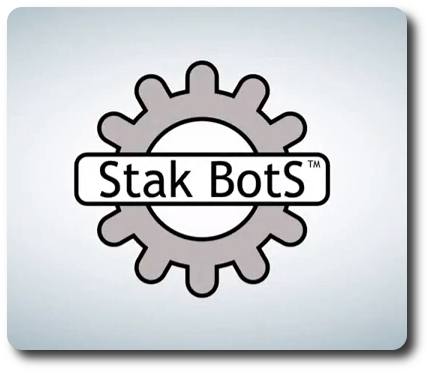
The Basics:
- For ages 7 and up
- For 2 to more players (using game variants)
- Variable game length to complete
Geek Skills:
- Counting & Math
- Logical & Critical Decision Making
- Reading
- Hand/Resource Management
Learning Curve:
- Child – Easy
- Adult – Easy
Theme & Narrative:
- Lead your army of Bots to crush those who dare second guess your opinion
Endorsements:
- Gamer Geek rejected!
- Parent Geek mixed!
- Child Geek approved!
Overview
The “Great Bickering” began with a simple question: “Why?” From there, every Bot generated their own opinion and every opinion was judged via a simple boolean algorithm. Camps were quickly formed, comprised of like-minded Bots who thought along the same code parameters. It quickly became apparent that compiling “differently” was dangerous. Skirmishes turned into battles and battles into wars. Join the fight and help your side of the argument win!
Stak Bots, designed by Tom Norfolk and published by DogEared Games, is comprised of 60 Bot cards and 2 Player Reference cards. The cards are thick, sturdy, and what you’d expect from a card game. The illustrations for the Bots are very minimalistic in design and the information on each card is short, but descriptive. Not included with the game, but nice to have, are a few counters to help keep track of damage inflicted on the poor defenseless bots.
Game Set Up
To set up the game, shuffle the 60 Bot cards and deal 9 out to each player, face-down. Players should NOT look at this pile of cards. This is the player’s “Stak” for the duration of the game. Players should organize them into a single pile. Each player will now flip and place the top Bot card on their Stak so it’s face-up and on top. This is the player’s first Bot. Any Entry Effects and Abilities are ignored.
Second, deal 2 Bot cards to each player, face-down. This is the player’s starting hand of cards. Players should look at their Bot cards, but keep them hidden from their opponents at all times.
Third, place the remaining Bot cards face-down in the middle of the playing area and within easy reach of all the players. This is the “Supply” draw deck. Leave room next to the draw deck for a discard pile which is referred to as the “Scrapheap”.
That’s it for game set up. Let the Great Bickering begin!
Bot Basics
Each Bot card has useful information that helps the player determine how strong the Bot is and identifies any “Entry Effects” or “Abilities” the Bot might have. Entry Effects (identified by the “>” symbol) are special actions that take place as soon as the Bot is placed face-up on a player’s Stak. These are one time actions. Abilities (identified with a “star” symbol) are special additional effects that will take place when the Bot is activated during combat. A Bot’s “sidebar” (located on the Bot card’s left most side when viewed face-up) provides a quick reference at a glance that shows the Bot’s information.
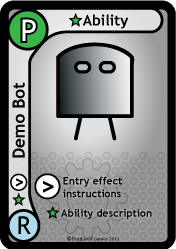
While both Entry Effects and Abilities are important to note and to use, a Bot’s “Power” value (located where the letter “P” is placed) is perhaps the most important stat. A Bot’s Power value indicates how much damage it will inflict on another Bot and how much damage it can withstand before it’s sent to the Scrapheap. In essence, the Power value represents both shield and sword, attack and defense.
Finally, the Rank value on a Bot card (located where the letter “R” is placed) suggests how much stronger it is compared to the other Bots in the game. A higher Rank value is considered stronger than a lower Rank value. However, even a very weak Bot can turn the tide in the game.
A complete list of all the Bots and details on any Entry Effects or Abilities they might have is available to you if you would like to learn more about each specific Bot.
Bot Bickering
Note: Stak Bots comes with basic rules that are summarized here. The game has been purposely made to be customizable, however, and there are a number of different ways to play it. See the “Game Variants” section below for details.
Stak Bots is played in turns with no set number of turns per game. On a player’s turn, they will complete the following sequential steps.
Step 1: Draw a Card
The first action a player takes on their turn is drawing 1 Bot card from the Supply draw deck. This card is added to their hand. If there are no Bot cards left in the Supply draw deck, shuffle the Bot cards in the Scrapheap to create a new Supply draw deck.
Step 2: Go Nuts
The next step on a players turn is comprised of multiple actions that can be taken in any order and as many times as the player likes. They are summarized here.
Play A Card
The player is welcome to play as many Bot cards from their hand as they like. When they are played, the Bot’s Entry Effect is triggered. Played Bot cards are placed on top of the player’s Stak. When placed, the face-up Stak cards should be organized so that all the player’s can see the left most sidebar of each of the Bot cards. In this way, the player and the player’s opponents can always see what Bot cards are currently active. Any Bot cards face-down in the Stak are considered offline.
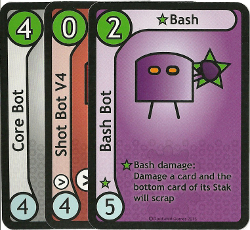
Note that there is no hand size limit and a player is never forced to play a card from their hand if they do not want to.
Attack
A player can attack an opponent’s Stak using their top most Bot card that is face-up on their own Stak. This is the only Bot card the player can use to attack with for their entire turn. If their attacking Bot is sent to the Scrapheap, flipped over, or returned to their hand during their turn, they cannot attack any other opponent until their next turn.
Combat is very simple. The two Bots engaged in combat reduce their target’s Power value by subtracting their own Power value from it. For example, if a Bot had a Power value of “5” and it was being attacked by a Bot with a Power value of “3”, the Bot with a Power value of “5” would have a new Power value of “2” (5 – 3 = 2). The Bot with a Power value of “3” has a new Power value of “-2” (3 – 5 = -2).
A Bot is still functioning as long as it has zero or more Power. This is where the counters we suggested you include in your game come in handy. Damage inflicted on a Bot builds up. Therefore, a very powerful Bot can engage in multiple attacks and take a great deal of damage before going down. While the individual Power level of a Bot might be reduced, the amount of damage the Bot inflicts does not. Regardless of the Bot’s current Power level, they continue to do maximum damage which is equal to the Bot’s Power level listed on the Bot card
If the player’s Bot is destroyed and sent to the Scrapheap, they cannot take any additional attack actions this turn. However, when an opponent’s Bot is sent to the Scrapheap, a new Bot will step forward to take its place immediately either from the top of the Stak or from the player’s hand. Any Entry Effects are triggered if a new Bot is flipped over face-up from the Stak or played from the player’s hand to the Stak. The player can continue their campaign of destruction against the same opponent or choose a new opponent each time they attack.
Note that any damage inflicted on any Bot is removed at the end of a player’s turn. A Bot’s Ability is always used and takes effect in the game when the Bot is engaged in combat. A Bot need not initiate an attack to use the Ability.
Scrap
Any Bot cards that have their Power reduced to less than zero are placed, face-up, in the Scrapheap. Note that some card Entry Effects and Abilities target Bot cards in Staks. For example, the “Bash” Bot card will force an opponent to discard the Bot card at the bottom of their Stak if the top Bot card takes damage. If the player removes the only face-up Bot card from their Stak, they immediately flip the top Bot card over and place it face-up on top of their Stak. Any Entry Effects and Abilities immediately activate.
Step 3: Feed the Scrap Discard Pile
If a Bot card (from any player) has not been added to the Scrapheap this turn, the player must now discard one Bot card from their hand or discard the top Bot card from their Stak. If the player removes the only face-up Bot card from their Stak, they immediately flip the top Bot card over and place it face-up on top of their Stak. Any Entry Effects and Abilities immediately activate.
Note that if a player ever runs out of cards in their Stak, they are out for the duration of the game, regardless of how many cards they might still have left in their hand.
Winning the Final Argument
The game continues until there is only 1 player left with Bot cards in their Stak. This player is the winner of the game.
Game Variants
There are also a number of game play variations that can be introduced to adjust the game’s difficulty or allow the game to accommodate more players. A few of our favorites are summarized here.
- Multi-Stak Game: Each player has 2 or more Staks they can play and attack from.
- Ranked Games: The Rank values on the Bot cards are used to create equally balanced Staks between all the players.
- Toggles: These are small adjustments to the game rules that introduce minor game play additions. For example, adjusting the number of cards in a player’s starting Stak, allowing reactive play (players can use cards from their hand when they are being attacked), and the ability to play your Bot cards on an opponent’s Stak!
To learn more about Stak Bots, visit the game’s official website.
Prediction
Stak Bots certainly sounds easy enough and should be an easy game to teach and to play. The lack of depth is going to cause most (if not all) of our Gamer Geeks to reject the game. There simply isn’t a great deal to consider when it’s a player’s turn, but some of the game variants might intrigue our gaming elitists. The game is very casual, which should appeal to our Parent Geeks and non-gamers who enjoy simple card games with friends and family. Where Stak Bots will find the most support is with the Child Geeks. The easy game play and straightforward turns will appeal to our younger players who just want to play a fast game and have fun doing it.
Teaching Stak Bots is best done by demonstrating a single turn with some combat thrown in. The only questions we were ever asked focused on card timing and the Scrapheap. The players wanted to know if Abilities and Entry Effects were triggered when a Bot was forced to reveal itself and go immediate to the Scrapheap. The answer is no. If a Bot is targeted for the Scrapheap, it goes immediately to the discard pile which does not trigger any of the Bot’s Abilities or Entry Effects.
Players need to be able to read to play the game. What little text there is on the Bot cards is very descriptive and informative. This information is used to help Players make tactical and strategic choices when it comes time to determine what actions should be taken on their turn. This is especially true when playing with the reactive play Toggle game variant. As such, the only real limitation to this game is a player’s reading ability.
After teaching the game to my oldest little geek, I asked him his thoughts on Stak Bots so far.
“Sounds like War, but with robots that look like Dots. Should be an easy game to play.” ~ Liam (age 9)
Ha! You know, my son is right. The Bots do look like Dots candy! Although, I think some of the Bots look more like the dreaded Octorok. Kids see the craziest things…
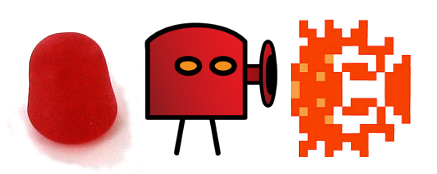
Let’s play Stak Bots and see how it stacks up against our groups’ likes and dislikes.
Final Word
The Child Geeks rather enjoyed Stak Bots and found it to be an easy to learn and fun to play game. None of our Child Geeks ever felt lost or out of step with the game play. The only negative comments were about players feeling picked on (because they were continuously attacked) and players not having better cards to be an effective opponent. But even games where nothing was going right hardly mad a dent in the Child Geeks’ enthusiasm. Every new hand of cards recharged the Child Geeks and they were eager to see what a fresh Stak provided. According to one Child Geek, “I like this game because it’s fast and easy for me to understand. I like playing it with my Daddy because I can beat him!” All the Child Geeks voted to approve the game when the Bots were put back in the box.
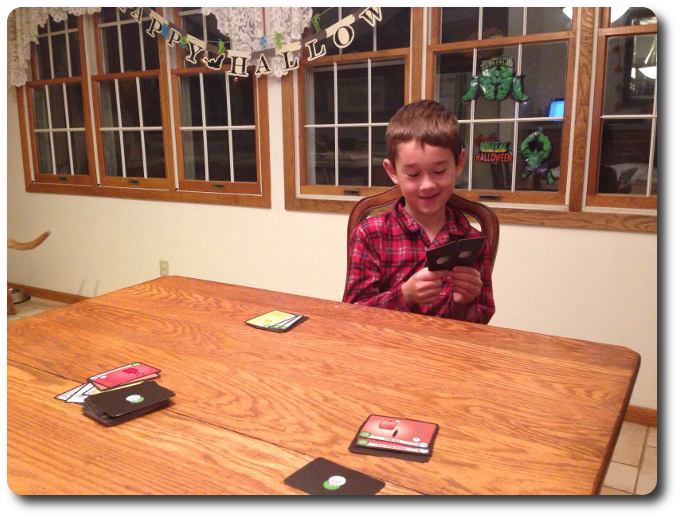
My little geek smirks as he draws the perfect card to squash my pathetic Bot uprising!
The Parent Geeks enjoyed playing the game with their Child Geeks, but were surprised how little there was to it. I was often asked, “Is this all there is to the game?” Yes, there isn’t much to Stak Bots. According to one non-gamer Parent Geek, “I’m surprised how little there is to this game and yet, I still feel like I’m playing a complete game here.” According to a Parent Geek who really didn’t care for the game, “This is just way to simple for me to enjoy. I just draw cards and then – what? – play them out? I might as well just play War.” And there it is again. That’s the second time the simple card game, War, was mentioned. And it wouldn’t be the last. The Parent geeks all agreed that the game was fun to play with their kids, and some Parent Geeks couldn’t see themselves wanting to play the game with just their peers. As such, Stak Bots met with mixed approval.
The Gamer Geeks were not impressed with Stak Bots. They found the game to be too simplistic and too random. According to one Gamer Geek, “I have no control in this game. I hate that.” When I pointed out that he could choose when to play a card or not, he just rolled his eyes at me. Clearly, that wasn’t the kind of control he was looking for. We tried a number of the game variants, but it did little to change the Gamer Geeks’ minds. What little thought is necessary in the game was never enough for the Gamer Geeks to enjoy. They played the game several times, realized that each game was different based on the card draws, but the game always ended the same way. “The winner is the player who is simply the luckiest”, said one Gamer Geek. Most of the Gamer Geeks agreed. One Gamer Geek, in the game’s defense said, “But we must consider that the players do have choices to make in this game. Do they attack this opponent or the other? Do they play this Bot card now or later?” Sometimes a choice could mean the difference between victory or defeat, but rarely. All the Gamer Geeks voted to reject Stak Bots, finding it to be too simple, too light, and too random to be a welcomed game at their elitist gaming tables.
I personally found Stak Bots to be an “OK game”. It’s pretty random, which is not a game mechanism I care for. I enjoy games where I can use strategy and tactics to guide the game play. With Stak Bots, I was at the mercy of randomness and luck. I did enjoy the game much more with some of the game variants, which I highly recommend experienced players use. The game will remain in my collection because my little geek really likes playing the game with me and his friends. He has even created his own game variant so his younger brothers who cannot read can play, too. That’s really cool.
Playing Stak Bots with 2 players is not very exciting. You attack as fast as you can and as hard as you can. And that’s it. When you throw in 3 or more players, you want to continue to attack, but the additional choice of which opponent to target makes the game a bit more interesting. Interesting, but not anymore difficult. The player who was usually attacked was the one who had the weakest visible Bot card. It was fun to see new Bots suddenly appear on top of the Stak that were vastly more powerful than the one above it and a few of the Bot cards do allow you to actually stack powers. Most of the time, however, the Bots that were on display and ready for battle were always randomly generated and then quickly scrapped.
Stak Bots isn’t going to win any awards for indepth game play, but it can most certainly be fun for the younger players. The Child Geeks really enjoyed the game and were able to take the deck of cards and play it with just their peers without issue. That is worth taking note of. It’s when we brought the game to more experienced players who enjoyed a challenge that required thought, foresight, strategy, and tactics that Stak Bots fell down. While it didn’t win the hearts and minds of adults, the Bots were well-loved by the little geeks who went to war with them again and again.
This game was given to Father Geek as a review copy. Father Geek was not paid, bribed, wined, dined, or threatened in vain hopes of influencing this review. Such is the statuesque and legendary integrity of Father Geek.




Stak Bots IOS is out now! It’s free!
https://itunes.apple.com/gb/app/stak-bots/id664624486